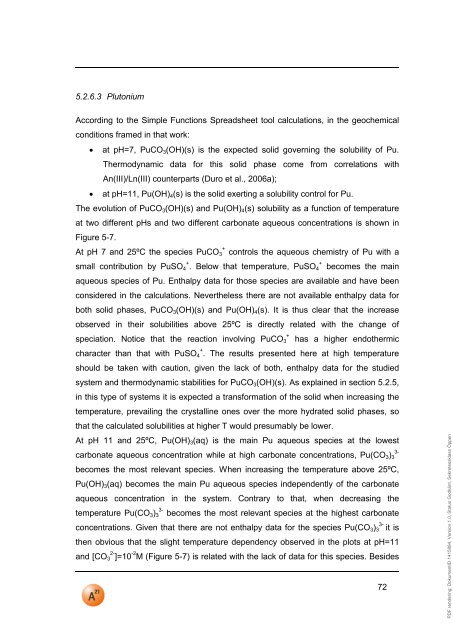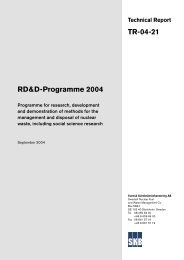pH = 11 - SKB
pH = 11 - SKB
pH = 11 - SKB
You also want an ePaper? Increase the reach of your titles
YUMPU automatically turns print PDFs into web optimized ePapers that Google loves.
PDF rendering: DokumentID 1415884, Version 1.0, Status Godkänt, Sekretessklass Öppen5.2.6.3 PlutoniumAccording to the Simple Functions Spreadsheet tool calculations, in the geochemicalconditions framed in that work: at <strong>pH</strong>=7, PuCO 3 (OH)(s) is the expected solid governing the solubility of Pu.Thermodynamic data for this solid phase come from correlations withAn(III)/Ln(III) counterparts (Duro et al., 2006a); at <strong>pH</strong>=<strong>11</strong>, Pu(OH) 4 (s) is the solid exerting a solubility control for Pu.The evolution of PuCO 3 (OH)(s) and Pu(OH) 4 (s) solubility as a function of temperatureat two different <strong>pH</strong>s and two different carbonate aqueous concentrations is shown inFigure 5-7.At <strong>pH</strong> 7 and 25ºC the species PuCO + 3 controls the aqueous chemistry of Pu with asmall contribution by PuSO + 4 . Below that temperature, PuSO +4 becomes the mainaqueous species of Pu. Enthalpy data for those species are available and have beenconsidered in the calculations. Nevertheless there are not available enthalpy data forboth solid phases, PuCO 3 (OH)(s) and Pu(OH) 4 (s). It is thus clear that the increaseobserved in their solubilities above 25ºC is directly related with the change ofspeciation. Notice that the reaction involving PuCO +3 has a higher endothermiccharacter than that with PuSO + 4 . The results presented here at high temperatureshould be taken with caution, given the lack of both, enthalpy data for the studiedsystem and thermodynamic stabilities for PuCO 3 (OH)(s). As explained in section 5.2.5,in this type of systems it is expected a transformation of the solid when increasing thetemperature, prevailing the crystalline ones over the more hydrated solid phases, sothat the calculated solubilities at higher T would presumably be lower.At <strong>pH</strong> <strong>11</strong> and 25ºC, Pu(OH) 3 (aq) is the main Pu aqueous species at the lowest3-carbonate aqueous concentration while at high carbonate concentrations, Pu(CO 3 ) 3becomes the most relevant species. When increasing the temperature above 25ºC,Pu(OH) 3 (aq) becomes the main Pu aqueous species independently of the carbonateaqueous concentration in the system. Contrary to that, when decreasing thetemperature Pu(CO 3 ) 3- 3 becomes the most relevant species at the highest carbonateconcentrations. Given that there are not enthalpy data for the species Pu(CO 3 ) 3- 3 it isthen obvious that the slight temperature dependency observed in the plots at <strong>pH</strong>=<strong>11</strong>and [CO 2- 3 ]=10 -2 M (Figure 5-7) is related with the lack of data for this species. Besides72
















